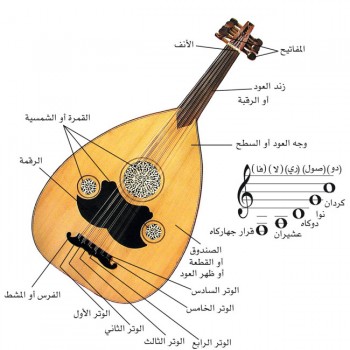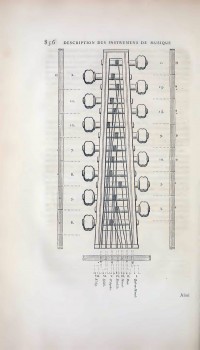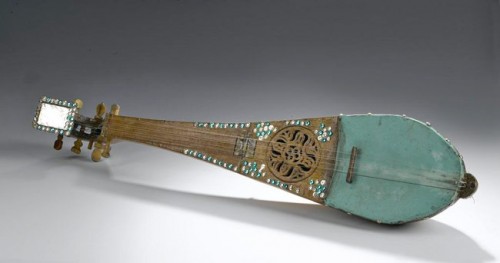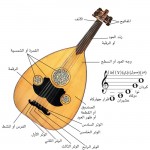The Arab Music Archiving and Research foundation (AMAR), in collaboration with the Sharjah Art Foundation (SAF), presents “Durūb al-Nagham”.
Dear listeners,
Welcome to a new episode of “Durūb al-Nagham”.
Today, we will resume our discussion about the ‘ūd with Mr Mustafa Said.
Hello Mr Mustafa Said.
Hello.
Tell us about the beginnings of ‘ūd, since we are discussing this subject. What early information do we have about the ‘ūd provided by documents and recordings?
There are Babylonian, Egyptian, Indian, and Chinese drawings of various instruments similar to our ‘ūd and whose origin surely dates back to these ancient civilisations. Still, one can’t affirm that the origin of the ‘ūd is Babylonian, Pharaonic, or Chinese. Furthermore, I doubt that today’s ‘ūd is the same as the one played three or four thousand years ago in Babel (or Babylon), or during the Pharaohs’ era… Simply because the nations are not the same anymore, races are mixed, peoples have changed, those present in Iraq today are not the Babylonians who lived at the time of Sumer and Babel… The same applies to Egypt where the people are not the same as those who lived during the Pharaohs’ era. Furthermore, the music played in China today is not the same music that was played one hundred years earlier, even though the Chinese civilisation is said to be the most stable and the closest today to what it was in the past… So it goes without saying that the other civilisations that are not as stable have undergone many changes.
There is also the industrial evolution.
The evolution…etc.
Added to the musical system and the role or place of the note…
Yes. So I can’t say that there is a link.
Well… there surely is one, but to say that the ‘ūd originates from a specific place, and that one was inspired for example by the musical system in Sumer or at the time of the Pharaohs, is far-fetched!
Those who study more are more aware of this: In brief, those who tackle the subject superficially would find that music is the same as it was five thousand years ago, whereas those who study the subject more deeply will know that there is no link between what is played today and what was played in the past, i.e. five thousand years ago. It is the same connection that links us to cavemen: all we know about them for sure is that we are their descendants.
Abbassid books such as “Kitāb al-Aghānī” mention that the ‘ūd is related to older instruments that were covered with skin. This allows us to start our discussion and provides a basis or rule we can rely on, especially that the instrument they are talking about, that was carved and had no ribs –a piece of carved wood resembling the violin– and is known as a “ṭarabī ṭāra”, “qanbūs ṭāra”, or “mazhar”, still shows signs of life in Yemen. Consequently, we can affirm that the ‘ūd is related to the barbaṭ that is covered with skin and has a relatively small sound box: a single piece of carved wood to which is attached the wooden neck for plucking, added to the skin wajh (soundboard) onto which the faras (bridge) is affixed. All these skins –goatskin, fishskin, or even camel skin even if it is heavier– were used to cover these instruments that are not our present ‘ūd.
In his book written at the beginning of the 11th century, Abū al-Ḥasan al-Ṭaḥḥān wrote that in the 9th or 10th century, there was an instrument that was made from wood and had ribs like our ‘ūd. Still, I remain very cautious about the information in Abū al-Ḥasan al-Ṭaḥḥān’s famous manuscript, because its copy was made in the 19th century when printing was possible… There is no older complete copy besides the one copied by hand in the 19th century, in 1250 Hijri or 1840 A.D., except for scattered papers…. Could we say that the copiers added elements related to the making in order, maybe, to make it more similar to theirs. Let us consider that they didn’t and that this is a faithful copy… still, nothing shows that the ‘ūd then looked like the one we know today.
What about the dimensions, the material…etc.?
It is measured in fingers and spans defined in Ibn Khaldūn’s writings, the finger being 2.5cm and the span 15cm. We can compare Abū al-Ḥasan al-Ṭaḥḥān’s measurements with modern measurements, relying on other manuscripts describing measurements at the time.
And try.
Yes, and try.
Of course, he talked about the wood used and mentioned the existence of two ‘ūd-s, a 4-string’ ‘ūd and a 5-string’ ‘ūd with Abū al-Ḥasan al-Ṭaḥḥān, adding that the 4-string’ ‘ūd was tuned to rābi‘a-s.
Let us discuss tuning: I doubt that the information in theory books reflects live practice, because the tuning of a 4-string’ ‘ūd is completely different from the tuning described in theory books, added to the poetry verse whose second hemistich is as follows: “If the sound of the bam and the sound of the zīr answer one another” which implies that the tuning of the first string and of the last string is the same, a qarār (low notes. bass) … and a jawāb (high notes. treble), one answering the other, and thus that the tuning was not to rābi‘a-s. On the other hand, the theory is translated from the Greeks’ books… they were consequently the safe keepers of these translations. Note that theory today does not reflect music practice; it is quite different from it.
Unfortunately.
And that is today… so just imagine how it was then.
Not all theorists were actual instrumentalists… In fact, not all theorists were even musicians. Consequently, I am not convinced that the theory reflects reality, except for some theories by those who practised music that may allow some comparison between people, between deductions, and some doubts, leading to data confirming that theory does not necessarily reflect live practice. Abū al-Ḥasan al-Ṭaḥḥān used a 4-string’ ‘ūd that he affirmed was the most widely spread. Some people added a fifth string.
After Abū al-Ḥasan…
The theorists include Ṣafī al-Dīn al-Urmawī and his descendants who mentioned a ‘ūd very similar to ours. The ‘ūd then had started to take the shape we know today. In fact, we can affirm that in Abū al-Ḥasan al-Ṭaḥḥān’s era, it was quite close to our ‘ūd. In the 14th and the 15th centuries, it had reached the appearance of today’s ‘ūd, with some differences as to the size and the dimensions: For example, ‘Abd al-Qādir al-Marāghī, a follower of Ṣafī al-Dīn al-Urmawī’s school or ṭarīqa, who came around one hundred years at least after him, theorized about the ‘ūd and gave the following appellations: the “qadīm or old 4-double string’ ‘ūd”, the “kāmil or complete 5-double string’ ‘ūd”, and the “akmal or most complete 6-double string’ ‘ūd” –We will talk about the double-string issue in a minute, in another story–. He was followed by his descendant Maḥmūd Bin ‘Abd al-‘Azīz at the beginning of the 16th century or 10th century Hijri, 908 Hijri or 1502 A.D., who served at the Ottoman court, probably under Sultan Murād the 1st, and wrote the same information mentioned by ‘Abd al-Qādir al-Marāghī, but added a 7-double string’ ‘ūd that he named the “mukammal or mukmal (completed) ‘ūd”.
Let us now talk about double-strings. Does the theory about 4, 5, 6, and 7 double-strings reflect the practice?
We have seen the qanbūs with 3 double-strings + 1 individual string, the 5-string’ ‘ūd with 4 double-strings + 1 individual string, the 6-string’ ‘ūd with 5 double-strings + 1 individual string, and the 7-string’ ‘ūd with 6 double-strings + 1 individual string… all that in practice.
I do not know if they said that all ‘ūd-s were double-string’ ‘ūd-s just to keep the theory coherent. Still, even the drawings –that we will be discussing right away– illustrate double string’ ‘ūd-s, and always with even numbered frets …
(♩)
There are some Ottoman drawings of 5-string’ ‘ūd-s, the same as with Dimitri Cantemir, and later at the end of the 18th century during Bonaparte’s campaign, in chapters 8 and 9 of “Waṣf Maṣr” (the description of Egypt), a surprise with Viloteau’s illustration of a 7-string’ ‘ūd. Later on, with Mikhā’īl Mashāqa and with Edward Lane, there are also illustrations of and theories on 7-string’ ‘ūd-s. In the late 19th century / early 20th century, Muḥammad Dhākir theorized about 6-string’ ‘ūd-s and wrote that some, rarely, added a seventh string. Early 20th century recordings are mostly of 5-string’ and 6-string’ ‘ūd-s. There are very few recordings of 7-string’ ‘ūd-s, including Muḥammad al-Qaṣṣabgī in the 1920s, knowing that he stopped playing 7-string’ ‘ūd-s in the late 1920s / early 1930s. We do not know why he used to play them then stopped.
It seems that there were 5, 6, and 7-string’ ‘ūd-s besides the 4-string’ ‘ūd covered with skin existing in Yemen called barbaṭ, and besides the Moroccan ‘ūd that is also called Tunisian ‘ūd, Algerian ‘ūd, or Andalusian ‘ūd according to the country or region, that has 4 strings –which raises questions about the story of Ziryāb and the fifth string– and comes in different sizes, and has different appellations, quwayṭara or ‘ūd.
Do the sources, throughout the years, give some importance to the appellations of the instrument, or do they all name it ‘ūd?
All call it ‘ūd.
What about the other instruments?
Which instruments?
Those similar to the ‘ūd… Are they mentioned?
There is the ‘ūd family and the ṭanbūr family, including the ‘ūd barbaṭ, the ‘ūd shabbūṭ, and the ‘ūd zalzal –so there are different types, yet they are all ‘ūd-s–; and the ṭanbūr baghdādī, the ṭanbūr khurasānī…
The point is that in the end it is all about a short-necked instrument called the ‘ūd and a long-necked instrument called the ṭanbūr.
What are the oldest recordings we can listen to?
The oldest existing recordings date back to the beginning of the recording era. They include Edison ‘ūd cylinder recordings of a singer accompanied only by his ‘ūd, without a takht, such as Sī ‘Abduh al-Ḥāmūlī and Ibrāhīm al-Qabbānī. … Either the sound could not take in many instruments, or they were just trying, or having fun, singing with their ‘ūd only, often recording a short ‘ūd taqsīma (instrumental musical improvisation) followed by the singing of the dawr.
Is there an old recording of a solo ‘ūd?
It is considered as a recording of a solo ‘ūd, whether the taqsīma is in the beginning or in the end, the singing is accompanied by a solo ‘ūd.
We could listen to something if you wish.
Let us listen…
(♩)
Mr Mustafa, what are the different types of ‘ūd-s –number of strings, nature, …etc.– in the early recordings of ‘ūd?
We just listened to a 5-string’ ‘ūd tuned according to the tuning we know, i.e.: the first or highest string being the yakāh, followed by the ‘ushayrān, the dukāh, the nawā, and the kardān. The distance between the first and the second string is a major thānya (one tone), then a rābi‘a (2 tones and a half), then a second rābi‘a then a third rābi‘a, i.e. 3 rābi‘a-s, on an ordinary 5 string’ ‘ūd.
It seems that the tuning of the qanbūs –or Yemeni ‘ūd or ṭarab– was the same, but without the kardān –or fifth string or second zīr– so the tuning between the bam or the yatīm and the second string is a major thānya (a tone), then a rābi‘a and another rābi‘a, the tuning of the bam and of the zīr is the same, qarār and jawāb, and the mathna and the mathlath are to the rābi‘a… The thick string (drone-string) was called the bam, then the mathna, then the mathlath, then the zīr.
We could discuss tuning in a future episode.
Yes.
Dear listeners, we have reached the end of today’s episode of “Durūb al-Nagham” about the ‘ūd presented with Mr Mustafa Said.
We will resume this discussion in our coming episodes.
Today’s episode was presented by Fadil al-Turki.
“Durūb al-Nagham”.
- 221 – Zakariyya Ahmed – 12 (1/9/2022)
- 220 – Zakariyya Ahmed – 11 (1/9/2022)
- 219 – Zakariyya Ahmed – 10 (11/25/2021)
- 218 – Zakariyya Ahmed – 9 (10/26/2021)
- 217 – Zakariyya Ahmed – 8 (9/24/2021)
- 216 – Zakariyya Ahmed – 7 (9/4/2021)
- 215 – Zakariyya Ahmed – 6 (8/28/2021)
- 214 – Zakariyya Ahmed – 5 (8/6/2021)
- 213 – Zakariyya Ahmed – 4 (6/26/2021)
- 212 – Zakariyya Ahmed – 3 (5/27/2021)
- 211 – Zakariyya Ahmed – 2 (5/1/2021)
- 210 – Zakariyya Ahmed – 1 (4/28/2021)
- 209 – W-al-Lāhi lā astaṭī‘u ṣaddak 2 (4/6/2017)
- 208 – W-al-Lāhi lā astaṭī‘u ṣaddak 1 (3/30/2017)
- 207 – Bashraf qarah baṭāq 7 (3/23/2017)




